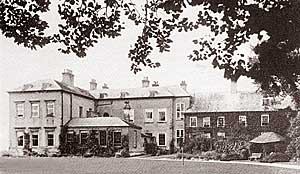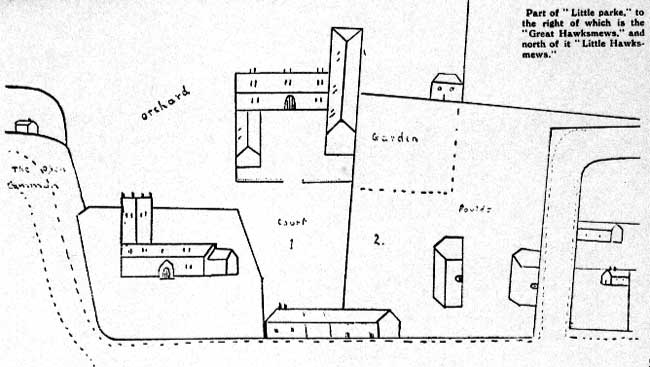
Grove Hall, c. 1900.
Anthony, the next lord of the Manor, was the younger brother of Diana. He married Judith Laetitia Bury, of Nottingham, grand-daughter and heiress of Sir Thomas Wasteneys, Bart, of Headon Park, county Notts. In 1762, he purchased of Mr. Levinz the estate of Grove, which joined the old family estate of Rampton and Treswell, on one side, and Headon on the other, which came to him by his wife. He then removed to Grove, where he made great alterations in the house and place, and made it his principal residence till his death. He served in several Parliaments for the borough of Boroughbridge. He was buried at Rampton on February 21st, 1788, aged 60. On the north wall of the church hangs his hatchment. It was painted by J. Hawley. On the north wall of the chancel there is also to his memory a tablet, with this inscription:—
"Sacred to the memory of Anthony Eyre, of Grove, esqr, who having discharged with integrity and assiduity the duties of a country gentleman and of a member of Parliament departed this life January 14th 1788, aged 60 years. Also of Judith Laetitia his wife, only daughter and heiress of John Bury of Grange near Grantham, esqr, and great niece and heiress of Sir Hardolph Wasteneys of Headon, Bart, whose virtues as a Christian, a Wife, a Parent, a Friend, were the fruit of an excellent understanding and the earliest and most assiduous cultivation. She died Rept 15th, 1800, aged 71 years. They had issue six children:—Julia, Anthony Hardolph, John, Caroline, Charles, and George."
His tombstone is beneath the Altar, and has the following inscription:—
"Here lieth the body of Anthony Eyre of Grove in
this county, who departed this life, Feb 11th 1788, in the
61st year of his age. Near him lieth the body of
Caroline his infant daughter, who died in 1765, aged
3 years. Within these rails also are interred the bodies
of both his parents, Anthony Eyre of Adwicke in the
county of York, who died Anno Dom 1749, and Margaret
his wife, daughter of Charles Turner of Kirkleatham in
the said county, Esqr, who died Anno Dom 1762."
He was succeeded by his eldest son, Anthony Hardolph Eyre, of Grove, born 8th March, 1757. He was brought up in the army, and obtained the rank of Lieut.-Colonel in the 1st Regiment of the Guards, and was for some years Member of Parliament for the county of Notts. He married, in 1783, Frances Alicia, third daughter of Richard Wilbraham Bootle, esqr., of Latham House, Lanes. By her he had one son, Gervas Anthony, born October 29th, 1791, who was also in the 1st Regiment of the Foot Guards, and was killed at the victory gained in Barrosa in Spain, in his twentieth year. A tablet to his memory, on the north wall of the chancel, bears this inscription:—
"Sacred to the memory of Gervas Anthony Eyre, esqr, only son of Hardolf and Alicia Eyre of Grove. Nat Oct 20 1791, occ Mar 5 1811. Endued with the most amiable disposition and with every virtue which could endear him to his family, his friends, and society in general, and with a vigour and energy of mind beyond his years, he was the delight of all that knew him, and promised to be an ornament and advantage to his country. But it pleased God that his career should be short though not inglorious. He fell in the moment of victory at the memorable battle of Barrosa March 5th 1811. His remains were interred with military honours at Isla de Leon, where a monument was erected to his memory.
His saltem accumulem donis et fungar inani munere."
There were also three daughters, whose names and marriages are inscribed on the tablet on the north side of the chancel to the memory of their parents, both of whom are buried at Rampton. It bears the following inscription:—
"Sacred to the memory of Anthony Hardolf Eyre, esqr, of Grove, eldest son of A. Eyre, esqr, born March 8, 1757, died April 13 1836. He was honourably distinguished by the useful discharge of many public duties, and by the endearing exercise of many private duties. In reward for the services which in various capacities he rendered to his native country he was unanimously elected as its member in three successive Parliaments. In 1812 he retired voluntarily from its representation, and passed the evening of his truly Christian life in the intelligent, but unostentatious practice of doing good to all men. He left three daughters surviving him. Mary Laetitia, wife of Charles Earl Manvers, Frances Julia, wife of Granville Harcourt Vernon, esqr, Henrietta, married 1st to the Rev. John Hardolph Eyre, 2nd to H. G. Knight, esqr." (Henry Gaily Knight of Firbeck Hall, Yorkshire.)
"Sacred to the memory of Francisca Alicia wife of Anthony Hardolf Eyre, esqr, of Grove, third daughter of Richard Wilbrabam Bootle, esqr, of Latham House in the County Palatine of Lancashire, ob 3rd Sept 1810, aet 47. To every virtue which could dignify and adorn human nature she united every quality which could endear her as a wife, a Parent, and a Friend. Her piety was warm and sincere, without ostentation. Her charity extensive and judicious: admired and beloved by her numerous friends : in her domestic circle she was almost adored: she devoted herself to the education of her children, and had the rare felicity to see them all grow up, answering in every respect to her fondest wishes, and to be spared the agony of losing any of them. She bore a long and painful illness with exemplary fortitude and resignation, and with humble gratitude to her Creator for the blessings which she had enjoyed in this life. She closed her eyes in pious confidence of being raised to a happy immortality."
On the death of Anthony Hardolf Eyre, the estate was divided between his second and third daughters. Frances Julia received the Headon and Grove estates, which by her marriage passed to the Vernons, but the Manor of Rampton remained in the Eyre family. Henrietta, the third daughter, married for her first husband her cousin, the Rev. John Hardolf Eyre; he died without issue, April 17th, 1818, aged twenty-six, two years after their marriage. The next heir to the estate was his brother, the Rev. Charles Wasteneys Eyre, Rector of Carlton-in-Lindric. He married, April 26th, 1821, Lucy Dorothea, daughter of John Robinson Foules, of Haslerton and Bucton, countv York. In 1853, he built the present manor house, where he resided until his death. A tablet to his memory is on the north wall of the chancel, on which is inscribed:—
"In a vault near this place rest the remains of the Rev. Charles Wasteneys Eyre, of Rampton, formerly Rector of Carlton-in-Lindric. He was born 7th March 1802, and died 30 Oct 1862." His wife died in 1886.
They had issue Henry, Arthur Stanhope, Lucy Harriet.
Henry was the next and last member of the Eyre family to hold the Manor of Rampton. Colonel Henry Eyre fought in the Crimea; he was wounded at the attack of the Redan; he served during the Indian Mutiny, was present at the siege and fall of Lucknow, and was present with Ross's Camel Corps at the fall of Calpee.
In 1893, Colonel Eyre sold the estate. The greater part, 1,400 acres, was sold by auction at Retford, June 5th, 1893. The manor house and two farms adjoining, were sold separately and purchased by the late Mr. Cottam, of South Leverton, who resided here for a few years. In 1902, it was purchased by Charles E. Ellis, J.P., Esqr., who in 1917 was made a K.C.B. in acknowledgment of his valuable services in connection with the Ministry of Munitions.
Colonel Eyre died at Lincoln, June, 1904, aged 70; his body was cremated, and his ashes were interred in Rampton Churchyard. He married Kathleen, daughter of the Rev. Robert Machell, who died December 20th, 1899, and is also buried in the churchyard. On the south wall of the chancel there is a small brass tablet to her memory.
On the chancel walls there are several tablets in memory of other members of the Eyre family; four of those on the south wall, and one on the north, were originally placed in Headon Church, but were removed to Rampton by the Rev. C. W. Eyre, about the year 1845, and the coffins are also said to have been removed at the same time. The tablets are inscribed as follows:—
On the north, Carolus Eyre, A.M, Antonii Eyre fil tert Ecclesiarum de Grove et de Headon Rector, 2 June 1796, aet 28.
On the south, Johannis Eyre Nottingham Archdeacani et de Babworth in comitatu Nottingham Rectoris obiit Vicessimo Tertio die Martii A.D 1830, aet 73.
Rev. Johannis Hardolph Eyre qui decessit decimo Septimo die Veneris A.D 1818, aet 26. Annae Mariae Eyre quae vita decessit Aug Calend 9 A.D 1826, aet 30.
Louisa Henrietta nata vii id Mart MDCCCIX eheu, donata est Kal Ap MDCCCXVI.
A tablet commemorates Vice-Admiral Sir George Eyre, K.C.B., the younger brother of Anthony Hardolph and the Ven. John Eyre, who was born 1769, died 1839, and was buried at Rampton.
Beneath the above, is one to the memory of Georgina Frances, eldest daughter of Vice-Admiral Eyre, who died April 2nd, 1849, aged forty-two years. And of her sister, Caroline Julia, who died September l7th, 1881. There is also one to the memory of his second son, Major General Sir William Eyre, K.C.B., who died in his fifty-fourth year at Bilton Hall, Warwickshire, September 6th, 1859.
And a brass tablet inscribed as follows:—In memory of Lieut. A. H. Eyre, H.M. gist Regt, only son of Sir W. Eyre, K.C.B, killed in the Ashantee War Feb. 4th 1874, aged 23 years."
The Old Manor House.
The site is given on the adjoining plan, which is taken from a map dated 1717. The house was demolished in 1726. How much of it dated earlier than 1540 we have no, means of knowing; it was enlarged, if not rebuilt, by John and Sauncia Babington about that time. The house in which Sauncia was born, if not the same, was on the same site, which no doubt had been the site of the Manor House from Norman times, when Nigellus de Rampton was lord of the manor.
To the west of the house was an orchard, one tree of which remains and still bears fruit, viz., a mulberry tree, which, no doubt, has flourished for 300 summers or more. In the reign of King James I., the growth of the mulberry tree was encouraged for the purpose of supplying its leaves as food for silk worms, but as a fruit tree it flourished long before that time.
The beautiful old gateway, previously described, was the private entrance of the lord of the manor to the churchyard.

Sketch of a map of Rampton, 1717.
